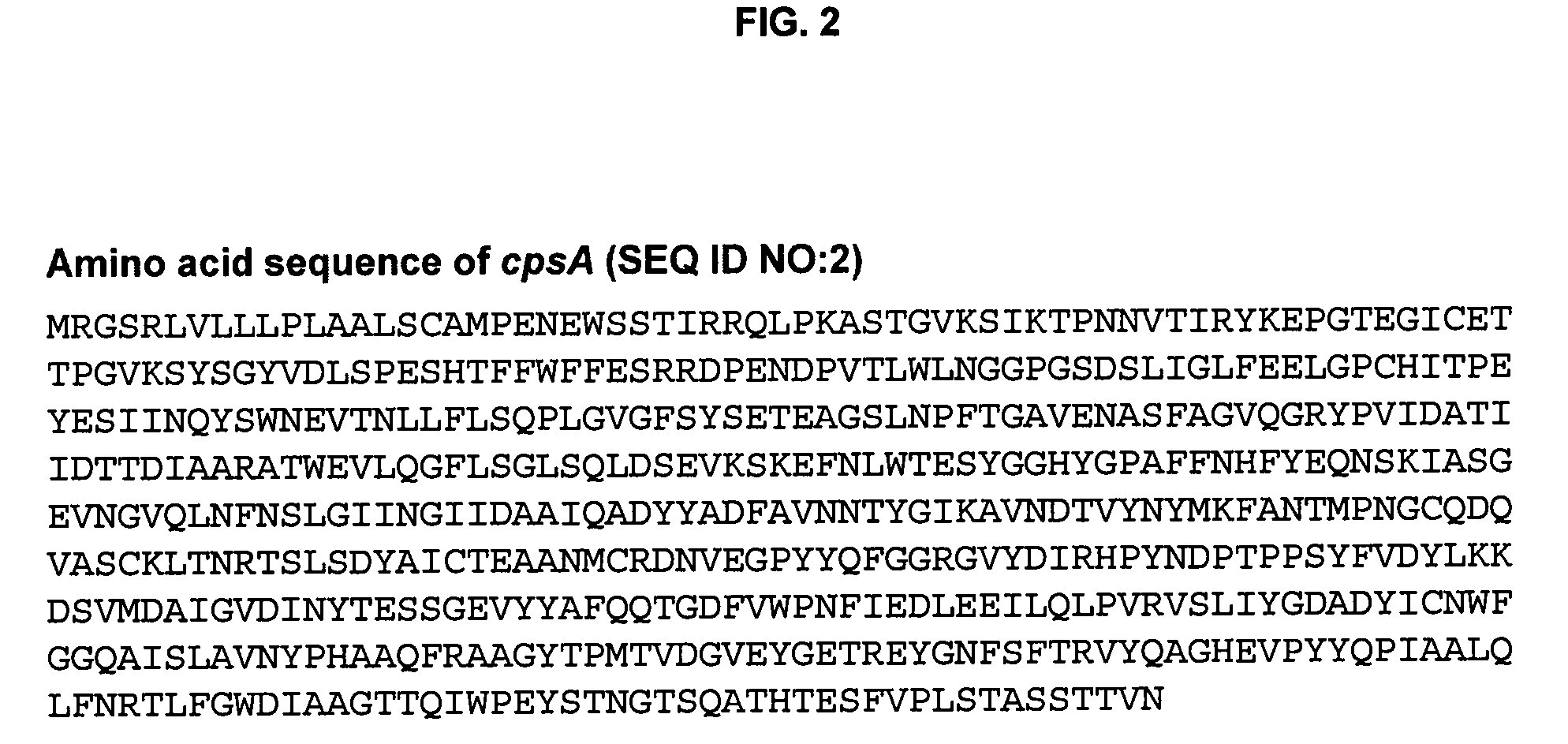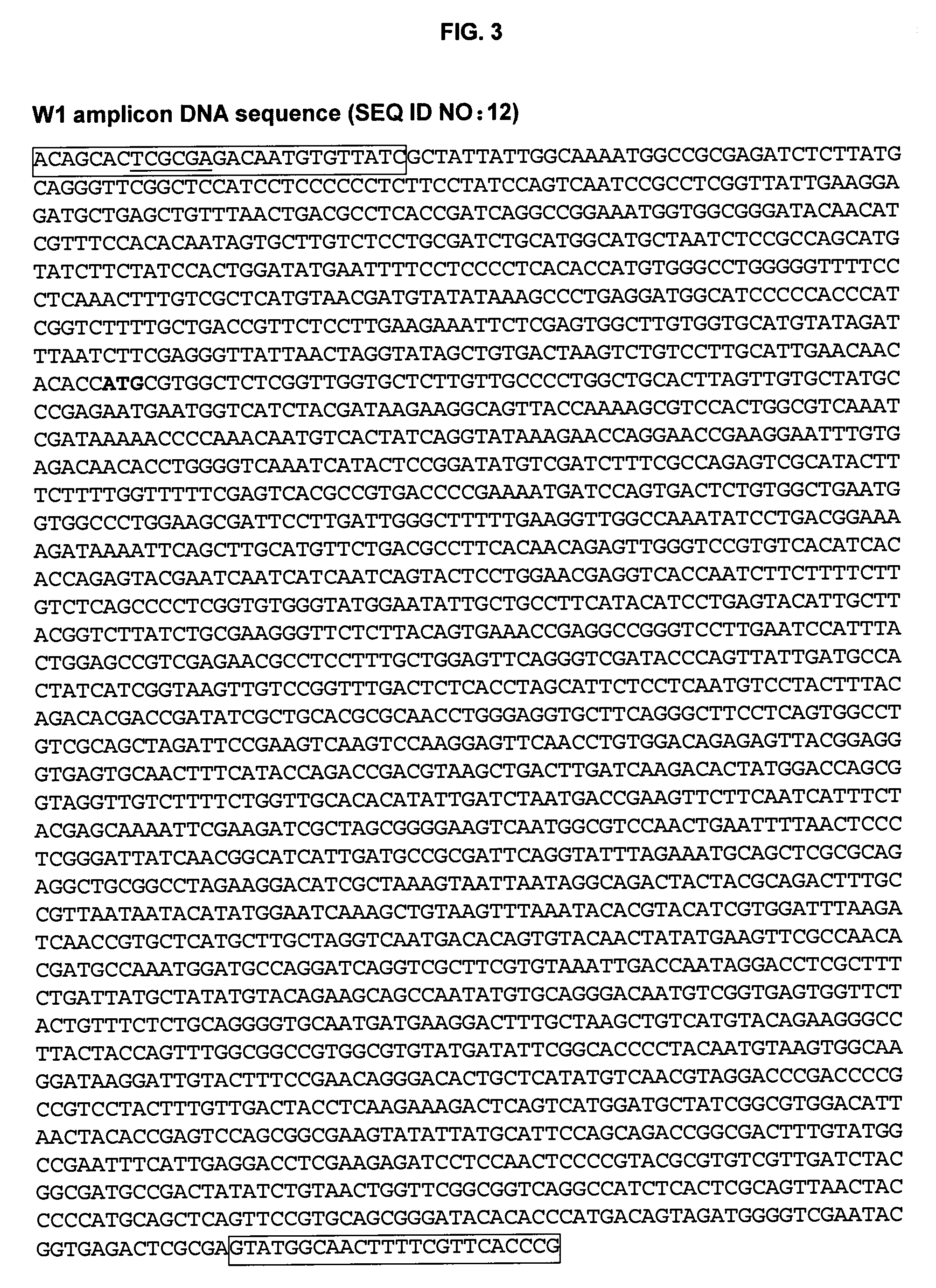Filamentous fungi with inactivated protease genes for altered protein production
a technology of inactivated protease and filamentous fungi, which is applied in the field of filamentous fungi with inactivated protease genes for altered protein production, can solve problems such as interference with efficient production
- Summary
- Abstract
- Description
- Claims
- Application Information
AI Technical Summary
Benefits of technology
Problems solved by technology
Method used
Image
Examples
example 1
Aspergillus niger Cells Having Inactivated cpsA Gene
[0168]a. Preparation of “disruption plasmid” having inactivated cpsA DNA construct
[0169]FIG. 1 depicts the 2188 bp genomic DNA sequence of the Aspergillus cpsA gene (SEQ ID NO: 1). FIG. 2 depicts the 552 amino acid sequence (SEQ ID NO: 2) encoded by the cpsA genomic DNA sequence of SEQ ID NO:1. Carboxypeptidases are proteases that cleave amino acids from the C-terminal end of a polypeptide.
[0170]The cpsA “disruption plasmid” is the DNA construct comprising the inactivated cpsA gene that is used to transform the A. niger cells and thereby generate the cpsA inactivated mutant microorganism. The general strategy and methods used to make the cpsA (and apsB) disruption plasmid used herein were the same as described in U.S. patent application publication no. 20060246545 A1, published Nov. 2, 2006, which is hereby incorporated by reference herein (see also, Wang et al., “Isolation of four pepsin-like protease genes from Aspergillus niger ...
example 2
Aspergillus niger Cells Having Inactivated apsB Gene
[0200]Unless otherwise noted, the same methods used in Example 1 were used to prepare an A. niger strain having inactivated apsB gene.
[0201]a. Preparation of “Disruption Plasmid” Having Inactivated apsB DNA Construct
[0202]FIG. 7 depicts the 3352 bp genomic DNA sequence of the Aspergillus niger aminopeptidase gene, apsB (SEQ ID NO: 9). FIG. 8 depicts the 881 amino acid sequence of the translated apsB protein (SEQ ID NO: 10). Aminopeptidases are proteases that remove amino acids from the N-terminal end of a polypeptide. The product of apsB is an intracellular enzyme (i.e., non-secreted protein) and consequently its activity is expected to be limited to affecting proteins within the cell.
[0203]Table 2 below depicts the primer sequences used to make the inactivated apsB disruption plasmid constructs.
TABLE 2PrimerNameSequence (5′ to 3′)PbACCCGACGTGGTGGTATGAATGCTC(SEQ ID NO: 11)TbAGGTGGCGAGTCGAGGGATTCGTAG(SEQ ID NO: 12)PP-outbACCGTAGGTAG...
example 3
Aspergillus niger Cells Having Triple Gene Inactivations
[0213]The production of a double mutant strain of A. niger, Δdpp4 / Δdpp5 amd, that has two inactivated dipeptidyl peptidase genes, dpp4 and dpp5 disrupted by the amdS selectable marker, was described in U.S. patent application publication no. 20060246545 A1, published Nov. 2, 2006, which is hereby incorporated by reference herein. This double-inactivation strain was used as a starting material to prepare triple-inactivation mutants of A. niger as described below.
[0214]a. Inactivated cpsA, dpp4 and dpp5
[0215]The cpsA disruption plasmid constructed and linearized as shown in Example 1 was used to transform the double-inactivation A. niger strain (Δdpp4 / Δdpp5 amd) which expresses a Tramete laccase under the glucoamylase promoter and terminator control.
[0216]The triple inactivation strain resulting from successful transformation was detected by PCR using three pairs of primers—one pair for each of the three inactivated genes. As in ...
PUM
| Property | Measurement | Unit |
|---|---|---|
| Tm | aaaaa | aaaaa |
| Tm | aaaaa | aaaaa |
| Tm | aaaaa | aaaaa |
Abstract
Description
Claims
Application Information
 Login to View More
Login to View More - R&D
- Intellectual Property
- Life Sciences
- Materials
- Tech Scout
- Unparalleled Data Quality
- Higher Quality Content
- 60% Fewer Hallucinations
Browse by: Latest US Patents, China's latest patents, Technical Efficacy Thesaurus, Application Domain, Technology Topic, Popular Technical Reports.
© 2025 PatSnap. All rights reserved.Legal|Privacy policy|Modern Slavery Act Transparency Statement|Sitemap|About US| Contact US: help@patsnap.com



